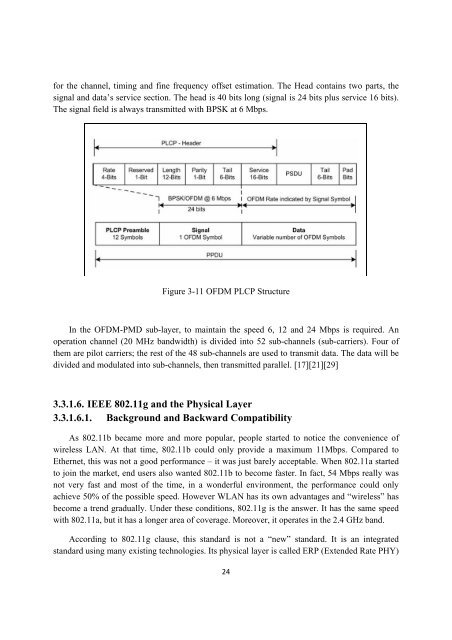A comparison of wi-fi and wimax with case studies - Florida State ...
A comparison of wi-fi and wimax with case studies - Florida State ...
A comparison of wi-fi and wimax with case studies - Florida State ...
You also want an ePaper? Increase the reach of your titles
YUMPU automatically turns print PDFs into web optimized ePapers that Google loves.
for the channel, timing <strong>and</strong> <strong>fi</strong>ne frequency <strong>of</strong>fset estimation. The Head contains two parts, the<br />
signal <strong>and</strong> data’s service section. The head is 40 bits long (signal is 24 bits plus service 16 bits).<br />
The signal <strong>fi</strong>eld is always transmitted <strong>wi</strong>th BPSK at 6 Mbps.<br />
Figure 3-11 OFDM PLCP Structure<br />
In the OFDM-PMD sub-layer, to maintain the speed 6, 12 <strong>and</strong> 24 Mbps is required. An<br />
operation channel (20 MHz b<strong>and</strong><strong>wi</strong>dth) is divided into 52 sub-channels (sub-carriers). Four <strong>of</strong><br />
them are pilot carriers; the rest <strong>of</strong> the 48 sub-channels are used to transmit data. The data <strong>wi</strong>ll be<br />
divided <strong>and</strong> modulated into sub-channels, then transmitted parallel. [17][21][29]<br />
3.3.1.6. IEEE 802.11g <strong>and</strong> the Physical Layer<br />
3.3.1.6.1. Background <strong>and</strong> Backward Compatibility<br />
As 802.11b became more <strong>and</strong> more popular, people started to notice the convenience <strong>of</strong><br />
<strong>wi</strong>reless LAN. At that time, 802.11b could only provide a maximum 11Mbps. Compared to<br />
Ethernet, this was not a good performance – it was just barely acceptable. When 802.11a started<br />
to join the market, end users also wanted 802.11b to become faster. In fact, 54 Mbps really was<br />
not very fast <strong>and</strong> most <strong>of</strong> the time, in a wonderful environment, the performance could only<br />
achieve 50% <strong>of</strong> the possible speed. However WLAN has its own advantages <strong>and</strong> “<strong>wi</strong>reless” has<br />
become a trend gradually. Under these conditions, 802.11g is the answer. It has the same speed<br />
<strong>wi</strong>th 802.11a, but it has a longer area <strong>of</strong> coverage. Moreover, it operates in the 2.4 GHz b<strong>and</strong>.<br />
According to 802.11g clause, this st<strong>and</strong>ard is not a “new” st<strong>and</strong>ard. It is an integrated<br />
st<strong>and</strong>ard using many existing technologies. Its physical layer is called ERP (Extended Rate PHY)<br />
24
















